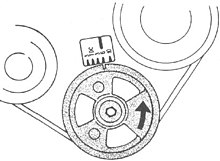
A pinch point or pinch point hazard is a common class of mechanical hazard where injury or damage may be done by one or more objects moving towards each other, crushing or shearing whatever comes between them. [1] A nip point is a type of pinch point involving rotating objects, such as gears and pulleys. [2] Injuries can range from minor such as blisters to severe like amputations and fatalities. [3] Examples of pinch point hazards include gaps in closing doors and objects swinging or being lowered near fixed objects. [4]
|
| This section needs expansion. You can help by
adding to it. (August 2020) |
Common causes of injuries
- Poor situational awareness [1]
- Proximity to mobile equipment and fixed structures [1]
- Loose clothing, hair or jewelry getting caught in rotating parts or equipment [1]
- Inadequate safety barriers [1]
- Handling errors [1]
- Wrong work procedures or tools [1]
- Reaching into moving equipment [1]
|
| This section needs expansion. You can help by
adding to it. (August 2020) |
Safety controls

Pre-work hazard inspections can be performed to identify pinch point hazards. These hazards can be managed with control methods, listed below according to the hazard control hierarchy. [1]
Engineering controls physically prevent objects from entering the pinch point.
- Barriers and machine guards [1]
Administrative controls inform worker behavior to avoid pinch points.
- Area demarcation [1]
- Lockout–tagout [1]
- Situational awareness [1]
- Use of appropriate training, [2] work procedures, instructions, and operating manuals [1]
Personal protective equipment protects individuals exposed to the hazard by preventing objects from being pinched. [1]
|
| This section needs expansion. You can help by
adding to it. (August 2020) |
.
See also
- Hazard – Situation or object that can cause damage
- Mechanical hazard- Hazard with a mechanical energy source
- Occupational hazard – Hazard experienced in the workplace
- Physical hazard – Hazard due to a physical agent
References
- ^ a b c d e f g h i j k l m n o "Causes and controls for preventing pinch point injuries". Industrial Safety and Hygiene News. 9 February 2018. Retrieved 8 August 2020.
- ^ a b "Woodworking eTool | Machine Hazards > Nip Points". www.osha.gov. Retrieved 2020-10-22.
- ^ Environmental Health and Safety. "WVU Pinch Point Hazards" (PDF). West Virginia University. Retrieved 15 October 2020.
- ^ Middle Georgia State University. "Pinch Points: Safety Training" (PDF). Retrieved 3 October 2020.